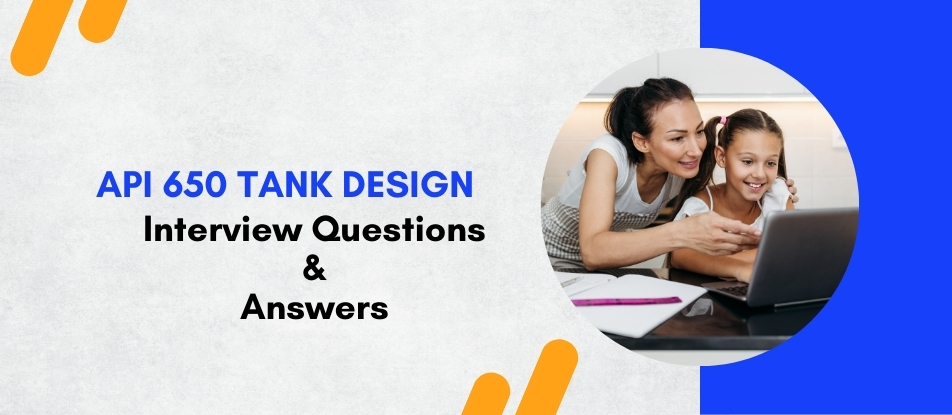
Enhance your expertise with our API 650 Tank Design Training Course. This comprehensive program covers the latest standards and best practices for designing welded storage tanks. Participants will learn structural analysis, material selection, fabrication techniques, and compliance requirements. Hands-on exercises and real-world case studies ensure practical understanding. It is ideal for engineers and industry professionals aiming to create safe, efficient, and code-compliant tank designs.
API 650 Tank Design Interview Questions Answers - For Intermediate
1. What is the primary purpose of API 650?
API 650 provides guidelines for the design, material selection, fabrication, erection, and testing of welded storage tanks for oil and other petroleum products. It ensures safety, structural integrity, and compliance with industry standards for aboveground tanks.
2. Describe the different roof types specified in API 650.
API 650 outlines several roof types, including fixed roofs, external floating roofs, internal floating roofs, and cone roofs. Each type is chosen based on factors like tank size, product volatility, and environmental conditions to minimize vapor loss and ensure structural stability.
3. What factors determine the minimum thickness of a tank shell in API 650?
Minimum shell thickness is determined by tank diameter, height, stored product pressure, wind and seismic loads, material strength, corrosion allowances, and joint efficiency. API 650 provides formulas and tables to calculate appropriate thickness.
4. Explain the significance of joint efficiency in API 650 tank design.
Joint efficiency reflects the strength of welded joints compared to the base metal. It accounts for weld quality and inspection methods. Higher efficiency allows for thinner shell sections, optimizing material use while ensuring structural integrity.
5. How does API 650 address seismic design considerations for tanks?
API 650 includes seismic design criteria based on geographical location and seismic zone. It prescribes additional reinforcement, anchoring methods, and structural enhancements to ensure tank stability and integrity during seismic events.
6. What are the main types of foundations recommended by API 650?
API 650 recommends foundations such as spread footings, mat foundations, and pile foundations. The choice depends on soil conditions, tank size, and load requirements to provide adequate support and prevent settlement or shifting.
7. Describe the process of selecting materials for API 650 tanks.
Material selection involves choosing appropriate carbon or low-alloy steel grades with suitable mechanical properties, corrosion resistance, and weldability. API 650 specifies permissible materials based on tank size, operating conditions, and stored product characteristics.
8. What role do nozzles play in API 650 tank design, and how are they sized?
Nozzles facilitate the entry and exit of products, ventilation, and instrumentation. Their sizing is based on flow rates, pressure requirements, and tank dimensions. Proper placement and sizing ensure efficient operation and prevent structural stress.
9. Explain the concept of membrane and vertical shell in API 650 tanks.
The membrane shell refers to the lower portion of the tank that primarily resists internal pressure through tension. The vertical shell above handles wind and seismic loads. This combination optimizes structural performance and material usage.
10. How does API 650 address corrosion protection for storage tanks?
API 650 mandates protective coatings, cathodic protection, and material selection to prevent corrosion. It also specifies maintenance practices and inspection intervals to ensure long-term integrity and minimize deterioration.
11. What are the requirements for tank bottom design in API 650?
Tank bottoms can be flat or conical, designed to withstand hydrostatic pressure, support foundations, and facilitate product drainage. API 650 provides design criteria based on tank size, product density, and operational conditions.
12. Describe the inspection and testing procedures outlined in API 650.
API 650 requires non-destructive testing (NDT) like radiography and ultrasonic testing for welds, hydrostatic testing for structural integrity, and visual inspections. These ensure compliance with design specifications and identify potential defects.
13. How are wind loads calculated for API 650 tanks?
Wind loads are calculated based on tank height, diameter, location, and regional wind speed data. API 650 provides formulas to determine the pressure exerted by wind, ensuring the tank structure can withstand expected forces.
14. What considerations are made for thermal expansion in API 650 tank design?
Designs accommodate thermal expansion through flexible joints, expansion loops, and appropriate anchoring. This prevents structural stress and potential damage from temperature-induced dimensional changes.
15. Explain the importance of venting in API 650 tanks.
Venting prevents pressure buildup or vacuum conditions during tank filling and emptying. Proper venting ensures safety, maintains structural integrity, and controls vapor emissions in compliance with environmental regulations.
16. How does API 650 address floating roof design?
API 650 specifies design criteria for floating roofs, including buoyancy, sealing, and movement mechanisms. Floating roofs minimize vapor loss and reduce fire hazards by maintaining a barrier between the product and the atmosphere.
17. What are the seismic anchorage requirements for API 650 tanks?
Seismic anchorage ensures tanks remain fixed to foundations during earthquakes. API 650 outlines methods for anchoring, including bolts and welds, and specifies calculations based on seismic zone, tank size, and structural loads.
18. Describe the role of computational methods in API 650 tank design.
Computational methods, including finite element analysis (FEA), help model tank behavior under various loads. API 650 encourages using these tools for complex designs to predict stress distribution and ensure compliance with standards.
19. How are overflow and drain systems integrated into API 650 tanks?
Overflow and drain systems are designed to manage excess products and facilitate maintenance. API 650 provides guidelines for sizing, placement, and materials to ensure effective operation without compromising tank integrity.
20. What maintenance practices does API 650 recommend for storage tanks?
API 650 recommends regular inspections, corrosion monitoring, coating maintenance, leak detection, and timely repairs. Adhering to these practices ensures longevity, safety, and compliance with regulatory standards.
API 650 Tank Design Interview Questions Answers - For Advanced
1. Explain the significance of the minimum required thickness in API 650 tank design and how it is determined.
The minimum required thickness ensures structural integrity against internal pressure, external loads, and corrosion. It’s calculated based on factors like tank diameter, height, material properties, temperature, and design pressure. API 650 provides formulas considering these variables to prevent failure, ensuring the safety and longevity of the storage tank.
2. Describe the role of butt welds in API 650 tank construction and the key acceptance criteria.
Butt welds join tank plates, ensuring leak-proof and strong connections. Key acceptance criteria include proper weld size, absence of defects (like cracks, and porosity), correct welding procedure adherence, and compliance with NDT methods. Quality butt welds are critical for structural integrity and preventing failures under operational stresses.
3. How does API 650 address seismic considerations in tank design, and what factors are evaluated?
API 650 incorporates seismic design criteria to ensure tanks withstand earthquake forces. Factors include geographical seismicity, tank height, diameter, foundation type, and support flexibility. Design adjustments may involve bracing, anchoring, and flexibility enhancements to mitigate seismic impacts, ensuring tank stability and integrity during seismic events.
4. What are the primary differences between API 650 and API 653 regarding tank design and maintenance?
API 650 focuses on the design and construction of new welded storage tanks, covering materials, welding, and structural integrity. API 653 deals with the inspection, repair, alteration, and maintenance of existing tanks. While API 650 ensures initial build quality, API 653 ensures ongoing safety and functionality through regular assessments and necessary interventions.
5. Explain the importance of foundation design in API 650 tanks and the key design parameters.
Foundation design ensures tank stability and load distribution. Key parameters include soil-bearing capacity, tank size, height, temperature effects, and environmental conditions. Proper foundation prevents differential settlement, tilting, and structural stresses, maintaining tank alignment and integrity under operational and environmental loads.
6. Discuss the impact of temperature variations on API 650 tank design and material selection.
Temperature variations affect material expansion, contraction, and stress. API 650 requires selecting materials with suitable thermal expansion coefficients and ensuring the design accommodates thermal movements. Insulation, joint flexibility, and appropriate material grades mitigate thermal stresses, preventing deformation, and cracking, and ensuring structural integrity across temperature ranges.
7. How does API 650 guide the design of roof systems for storage tanks, particularly regarding wind and snow loads?
API 650 provides guidelines for selecting roof types (e.g., cone, floating) based on tank size and contents. It specifies load calculations for wind and snow, ensuring roofs can withstand maximum expected forces. Design includes appropriate bracing, material selection, and geometric considerations to prevent roof failure and maintain containment integrity under adverse weather conditions.
8. What are the critical considerations for corrosion allowance in API 650 tank design?
Corrosion allowance compensates for material loss over time. Critical considerations include the stored product’s corrosiveness, environmental exposure, and maintenance practices. API 650 specifies minimum thickness additions based on corrosion rates and inspection intervals, ensuring the tank maintains structural integrity throughout its service life despite material degradation.
9. Describe the methods used in API 650 for hydrostatic testing of storage tanks and its purpose.
Hydrostatic testing involves filling the tank with water and pressurizing it above design pressure to check for leaks and structural integrity. API 650 outlines procedures for test pressure, duration, and safety measures. The purpose is to verify weld quality, detect defects, and ensure the tank can safely operate under intended pressures without failures.
10. Explain the significance of wind bracing in API 650 tank design and how it is implemented.
Wind bracing resists lateral forces from wind, preventing tank deformation or collapse. API 650 specifies bracing patterns, spacing, and materials based on tank size and wind load requirements. Implementation includes horizontal and vertical braces, anchors, and supports integrated into the tank’s framework, ensuring stability and maintaining structural integrity under high wind conditions.
Course Schedule
| Apr, 2025 | Weekdays | Mon-Fri | Enquire Now |
| Weekend | Sat-Sun | Enquire Now | |
| May, 2025 | Weekdays | Mon-Fri | Enquire Now |
| Weekend | Sat-Sun | Enquire Now |
Related Courses
Related Articles
- A Detailed Comparison of SAP Ariba, SRM, and MM Course
- What Makes Emerson DeltaV DCS Training So Valuable Today?
- Master Networking with Professional Cloud Network Engineer Training
- Elevate Your Finance Game with Murex Training
- Exploring the Latest Features and Updates in SAP ARIBA- What Procurement Professionals Need to Know?
Related Interview
Related FAQ's
- Instructor-led Live Online Interactive Training
- Project Based Customized Learning
- Fast Track Training Program
- Self-paced learning
- In one-on-one training, you have the flexibility to choose the days, timings, and duration according to your preferences.
- We create a personalized training calendar based on your chosen schedule.
- Complete Live Online Interactive Training of the Course
- After Training Recorded Videos
- Session-wise Learning Material and notes for lifetime
- Practical & Assignments exercises
- Global Course Completion Certificate
- 24x7 after Training Support









 Join our Live Instructor-Led online classes delivered by industry experts
Join our Live Instructor-Led online classes delivered by industry experts